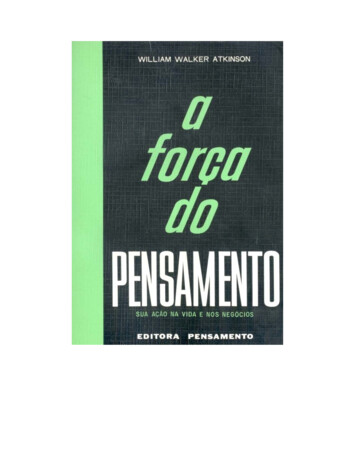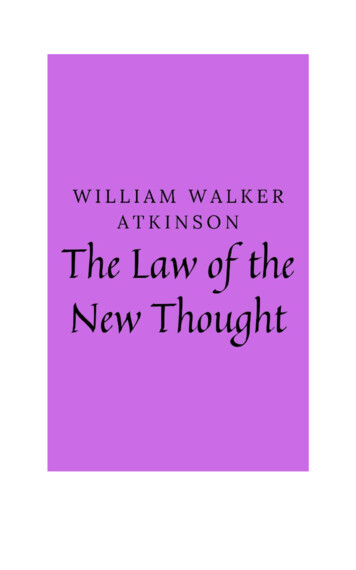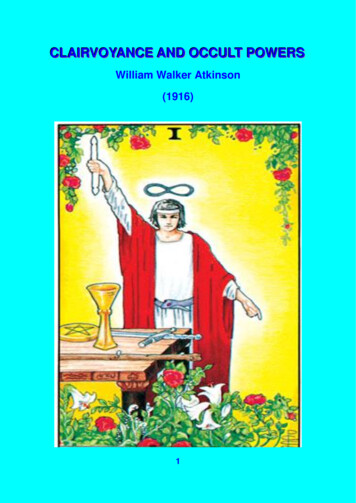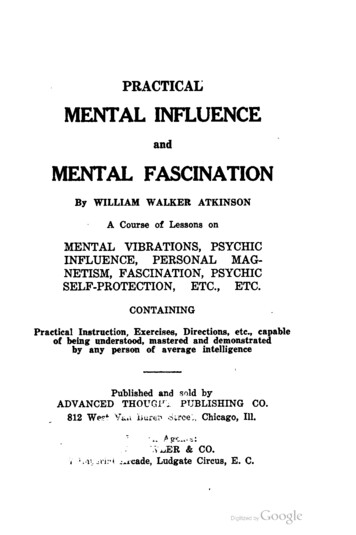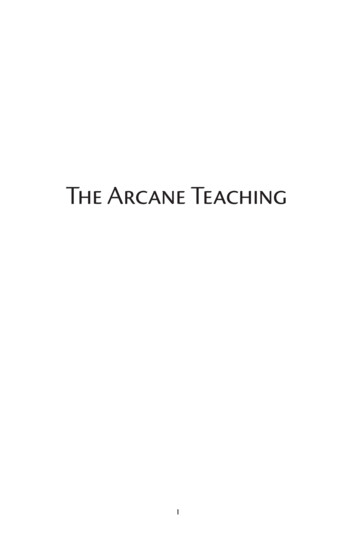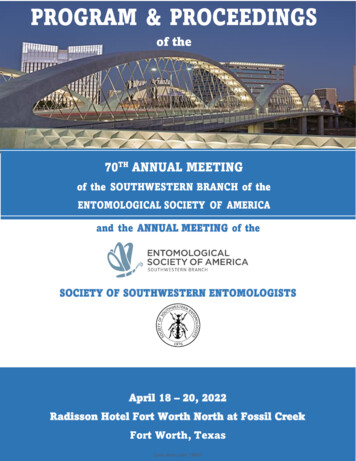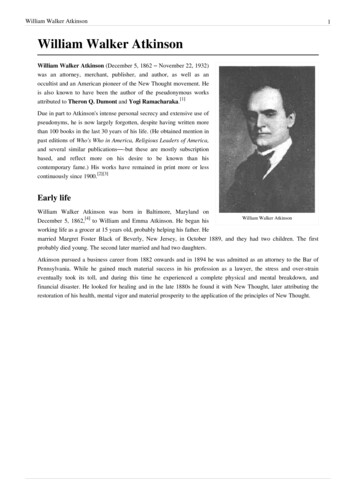
Transcription
William Walker AtkinsonWilliam Walker AtkinsonWilliam Walker Atkinson (December 5, 1862 – November 22, 1932)was an attorney, merchant, publisher, and author, as well as anoccultist and an American pioneer of the New Thought movement. Heis also known to have been the author of the pseudonymous worksattributed to Theron Q. Dumont and Yogi Ramacharaka.[1]Due in part to Atkinson's intense personal secrecy and extensive use ofpseudonyms, he is now largely forgotten, despite having written morethan 100 books in the last 30 years of his life. (He obtained mention inpast editions of Who's Who in America, Religious Leaders of America,and several similar publications—-but these are mostly subscriptionbased, and reflect more on his desire to be known than hiscontemporary fame.) His works have remained in print more or lesscontinuously since 1900.[2][3]Early lifeWilliam Walker Atkinson was born in Baltimore, Maryland onWilliam Walker AtkinsonDecember 5, 1862,[4] to William and Emma Atkinson. He began hisworking life as a grocer at 15 years old, probably helping his father. Hemarried Margret Foster Black of Beverly, New Jersey, in October 1889, and they had two children. The firstprobably died young. The second later married and had two daughters.Atkinson pursued a business career from 1882 onwards and in 1894 he was admitted as an attorney to the Bar ofPennsylvania. While he gained much material success in his profession as a lawyer, the stress and over-straineventually took its toll, and during this time he experienced a complete physical and mental breakdown, andfinancial disaster. He looked for healing and in the late 1880s he found it with New Thought, later attributing therestoration of his health, mental vigor and material prosperity to the application of the principles of New Thought.1
William Walker Atkinson2Death Certificate for William Walker AtkinsonMental Science and New ThoughtSome time after his healing, Atkinson began to write articles on the truths he felt he had discovered, which were thenknown as Mental Science. In 1889, an article by him entitled "A Mental Science Catechism," appeared in CharlesFillmore's new periodical, Modern Thought.By the early 1890s Chicago had become a major centre for New Thought, mainly through the work of Emma CurtisHopkins, and Atkinson decided to move there. Once in the city, he became an active promoter of the movement asan editor and author. He was responsible for publishing the magazines Suggestion (1900–1901), New Thought(1901–1905) and Advanced Thought (1906–1916).In 1900 Atkinson worked as an associate editor of Suggestion, a New Thought Journal, and wrote his probable firstbook, Thought-Force in Business and Everyday Life, being a series of lessons in personal magnetism, psychicinfluence, thought-force, concentration, will-power, and practical mental science.He then met Sydney Flower, a well-known New Thought publisher and businessman, and teamed up with him. InDecember, 1901 he assumed editorship of Flower's popular New Thought magazine, a post which he held until 1905.During these years he built for himself an enduring place in the hearts of its readers. Article after article flowed fromhis pen. Meanwhile he also founded his own Psychic Club and the so-called "Atkinson School of Mental Science".Both were located in the same building as Flower's Psychic Research and New Thought Publishing Company.Atkinson was a past president of the International New Thought Alliance.Publishing career and use of pseudonymsThroughout his subsequent career, Atkinson wrote and published under his own name and many pseudonyms. It isnot known whether he ever acknowledged authorship of these pseudonymous works, but all of the supposedlyindependent authors whose writings are now credited to Atkinson were linked to one another by virtue of the factthat their works were released by a series of publishing houses with shared addresses and they also wrote for a seriesof magazines with a shared roster of authors. Atkinson was the editor of all of those magazines and hispseudonymous authors acted first as "contributors" to the periodicals, and were then spun off into their own
William Walker Atkinsonbook-writing careers—with most of their books being released by Atkinson's own publishing houses.One key to unravelling this tangled web of pseudonyms is found in "Advanced Thought" magazine, billed as "AJournal of The New Thought, Practical Psychology, Yogi Philosophy, Constructive Occultism, MetaphysicalHealing, Etc."This magazine, edited by Atkinson, advertised articles by Atkinson, Yogi Ramacharaka, and Theron Q.Dumont—the latter two being pseudonyms of Atkinson—and it had the same address as The Yogi PublishingSociety, which published the works attributed to Yogi Ramacharaka.Advanced Thought magazine also carried articles by Swami Bhakta Vishita, but when it came time for Vishita'swritings to be collected in book form, they were not published by the Yogi Publishing Society. Instead they werepublished by The Advanced Thought Publishing Co., the same house that brought out the Theron Q. Dumontbooks—and published Advanced Thought magazine.Hinduism and yogaIn the 1890s, Atkinson had become interested in Hinduism and after 1900 he devoted a great deal of effort to thediffusion of yoga and Oriental occultism in the West. It is unclear at this late date whether he actually ever convertedto any form of Hindu religion, or merely wished to write on the subject. If he did convert, he left no record of theevent.According to unverifiable sources, while Atkinson was in Chicago at the World's Columbian Exposition in 1893, hemet one Baba Bharata, a pupil of the late Indian mystic Yogi Ramacharaka (1799 - c.1893). As the story goes,Bharata had become acquainted with Atkinson's writings after arriving in America, the two men shared similar ideas,and so they decided to collaborate. While editing New Thought magazine, it is claimed, Atkinson co-wrote withBharata a series of books which they attributed to Bharata's teacher, Yogi Ramacharaka. This story cannot beverified and—like the "official" biography that falsely claimed Atkinson was an "English author" -- it may be afabrication.No record exists in India of a Yogi Ramacharaka, nor is there evidence in America of the immigration of a BabaBharata. Furthermore, although Atkinson may have travelled to Chicago to visit the 1892 - 1893 World's ColumbianExposition, where the authentic Indian yogi Swami Vivekananda attracted enthusiastic audiences, he is only knownto have taken up residence in Chicago around 1900 and to have passed the Illinois Bar Examination in 1903.Atkinson's claim to have an Indian co-author was actually not unusual among the New Thought and New Agewriters of his era. As Carl T. Jackson made clear in his 1975 article The New Thought Movement and the NineteenthCentury Discovery of Oriental Philosophy,[5] Atkinson was not alone in embracing a vaguely exotic "orientalism" asa running theme in his writing, nor in crediting Hindus, Buddhists, or Sikhs with the possession of special knowledgeand secret techniques of clairvoyance, spiritual development, sexual energy, health, or longevity.The way had been paved in the mid to late 19th century by Paschal Beverly Randolph, who wrote in his books Eulisand Seership that he had been taught the mysteries of mirror scrying by the deposed Indian Maharajah Dalip Singh.Randolph was known for embroidering the truth when it came to his own autobiography (he claimed that his motherFlora Randolph, an African American woman from Virginia, who died when he was eleven years old, had been aforeign princess) but he was actually telling the truth—or something very close to it, according to his biographerJohn Patrick Deveney—when he said that he had met the Maharajah in Europe and had learned from him the properway to use both polished gemstones and Indian "bhattah mirrors" in divination.[6]In 1875, the year of Randolph's death, the Ukrainian-born Helena Petrovna Blavatsky founded the TheosophicalSociety, by means of which she spread the teachings of mysterious Himalayan enlightened yogis, the Masters of theAncient Wisdom, and the doctrines of the Eastern philosophy in general. After this pioneer work, somerepresentatives from known lineages of Indian and Asian spiritual and philosophical tradition like Vivekananda,Anagarika Dharmapala, Paramahansa Yogananda, and others, started coming to the West.3
William Walker AtkinsonIn any case, with or without a co-author, Atkinson started writing a series of books under the name YogiRamacharaka in 1903, ultimately releasing more than a dozen titles under this pseudonym. The Ramacharaka bookswere published by the Yogi Publication Society in Chicago and reached more people than Atkinson's New Thoughtworks did. In fact, all of his books on yoga are still in print today.Atkinson apparently enjoyed the idea of writing as a Hindu so much that he created two more Indian personas,Swami Bhakta Vishita and Swami Panchadasi. Strangely, neither of these identities wrote on Hinduism. Theirmaterial was for the most part concerned with the arts of divination and mediumship, including "oriental" forms ofclairvoyance and seership. Of the two, Swami Bhakta Vishita was by far the more popular, and with more than 30titles to his credit, he eventually outsold even Yogi Ramacharaka.A French master of magnetismDuring the 1910s, Atkinson put his attention into another pseudonym, that of Theron Q. Dumont. This entity wassupposed to be French, and his works, written in English and published in Chicago, combined an interest in NewThought with ideas about the training of the will, memory enhancement, and personal magnetism.Dual career and later yearsIn 1903, the same year that he began his writing career as Yogi Ramacharaka, Atkinson was admitted to the Bar ofIllinois. Perhaps it was a desire to protect his ongoing career as a lawyer that led him to adopt so manypseudonyms—but if so, he left no written account documenting such a motivation.How much time Atkinson devoted to his law practice after moving to Chicago is unknown, but it is unlikely to havebeen a full-time career, given his amazing output during the next 15 years as a writer, editor, and publisher in thefields of New Thought, yoga, occultism, mediumship, divination, and personal success.The high point of his prodigious capacity for production was reached in the late 1910s. In addition to writing andpublishing a steady stream of books and pamphlets, Atkinson started writing articles for Elizabeth Towne's NewThought magazine Nautilus, as early as November 1912, while from 1916 to 1919, he simultaneously edited his ownjournal Advanced Thought. During this same period he also found time to assume the role of the honorary presidentof the International New Thought Alliance.Among the last collaborators with whom Atkinson may have been associated was the mentalist C. Alexander, "TheCrystal Seer," whose New Thought booklet of affirmative prayer, "Personal Lessons, Codes, and Instructions forMembers of the Crystal Silence League", published in Los Angeles during the 1920s, contained on its last page anadvertisement for an extensive list of books by Atkinson, Dumont, Ramacharaka, Vishita, and Atkinson's collabrator,the occultist L. W. de Laurence.Atkinson died November 22, 1932 in Los Angeles, California at the age of 69, after 50 years of simultaneouslysuccessful careers in business, writing, occultism, and the law.Many mysteries still surround Atkinson's life, including the fact that a certificate of copyright issued three years afterhis death is said to have been signed by the author himself.WritingsAtkinson was a prolific writer, and his many books achieved wide circulation among New Thought devotees andoccult practitioners. He published under several pen names, including Magus Incognito, Theodore Sheldon, TheronQ. Dumont, Swami Panchadasi, Yogi Ramacharaka, Swami Bhakta Vishita, and probably other names not identifiedat present. He is also popularly held to be one (if not all) of the Three Initiates who anonymously authored TheKybalion, which certainly resembles Atkinson's other writings in style and subject matter. Atkinson's two co-authorsin the latter venture, if they even existed, are unknown, but speculation often includes names like Mabel Collins,4
William Walker AtkinsonMichael Whitty, Paul Foster Case, and Harriett Case.A major collection of Atkinson's works is among the holdings of a Brazilian organization called Circulo de EstudosRamacháraca. According to this group, Atkinson has been identified as the author or co-author (with individualssuch as Edward E. Beals and Lauron William de Laurence) of 105 separate titles. These can be broken down roughlyinto the following groups:[7]Titles written under the name William Walker AtkinsonThese works treat themes related to the mental world, occultism, divination, psychic reality, and mankind's nature.They constitute a basis for what Atkinson called "New Psychology" or "New Thought". Titles include ThoughtVibration or the Law of Attraction in the Thought World, and Practical Psychomancy and Crystal Gazing: A Courseof Lessons on the Psychic Phenomena of Distant Sensing, Clairvoyance, Psychometry, Crystal Gazing, etc.Although most of the Atkinson titles were published by Atkinson's own Advanced Thought Publishing Company inChicago, with English distribution by L. N. Fowler of London, England, at least a few of his books in the "NewPsychology" series were published by Elizabeth Towne in Mount Holyoke, Massachusetts, and offered for sale inher New Thought magazine The Nautilus. One such title, for which Atkinson is credited as the author, with thecopyright internally assigned to Towne, is The Psychology of Salesmanship, published in 1912. The probable reasonthat Atkinson made an assignment of copyright to Towne is that his "New Psychology" books had initially beenserialized in Towne's magazine, where he was a freelance writer from 1912 at least through 1914.Titles written under pseudonymsThese include Atkinson's teachings on Yoga and Oriental philosophy, as well as New Thought and occult titles. Theywere written in such a way as to form a course of practical instruction.Yogi Ramacharaka titlesWhen Atkinson wrote under the pseudonym Yogi Ramacharaka, he claimed to be a Hindu. As Ramacharaka, hehelped to popularize Eastern concepts in America, with Yoga and a broadly-interpreted Hinduism being particularareas of focus. The works of Yogi Ramacharaka were published over the course of nearly ten years beginning in1903. Some were originally issued as a series of lectures delivered at the frequency of one lesson per month.Additional material was issued at each interval in the form of supplementary text books.Ramacharaka's Advanced Course in Yoga Philosophy and Oriental Occultism remains widely respected as anexcellent primer for the Western layman, despite the fact that it was 100 years old in 2004 and is understandablydated in some respects.According to Atkinson's publisher, the Yogi Publication Society, some of these titles were inspired by a student ofthe "real" Yogi Ramacharaka, Baba Bharata, although there is no historical record that either of these individualsever existed.In reply to inquiries about Yogi Ramacharaka, this official information was provided by the Yogi PublicationSociety:"Ramacharaka was born in India in about the year 1799. He set forth at an early age to educate himself and toseek a better philosophy for living."Traveling throughout the East almost always on foot, he visited the depositories of books available. Theprimary places where libraries were open to him were lamaseries and monasteries, although with the passingof time some private libraries of royalty and of wealthy families were also thrown open to him."In about the year 1865, after many years of searching and many visits to the lonely high places where hecould fast and meditate, Ramacharaka found a basis for his philosophy. At about this same time, he took as apupil, Baba Bharata, who was the eight year old son of a Brahmin family. Together teacher and pupil retraced5
William Walker Atkinsonthe steps of the teacher's earlier travels, while Ramacharaka indoctrinated the boy with his philosophy."In 1893, feeling that his life was drawing to a close, Ramacharaka sent his pupil forth to carry their beliefs tothe new world. Arriving in Chicago where the World Columbian Exposition was in progress, Baba Bharatawas an instant success. He lectured before enthusiastic audiences from all parts of the world who were visitingthe Fair, attracting a considerable following in the process. Many wished him to start a new religion - but hefelt only the drive to write on the subject which he lectured on so effectively."In the closing years of the 1800s, Baba Bharata became acquainted with William Walker Atkinson, anEnglish author who had written along similar lines and whose books had been published by ourselves and byour London connection, L. N. Fowler & Company Ltd."The men collaborated and with Bharata providing the material and Atkinson the writing talent, they wrote thebooks which they attributed to Yogi Ramacharaka as a measure of their respect. The very fact that after allthese years their books are well known around the world and sell better with every passing year is a credit, too,to the two men who wrote the books."Note that in at least one point, this "official" account is false: William Walker Atkinson was an American, not "anEnglish author" and L. N. Fowler, an occult publishing house, was the British publisher of books that Atkinson hadpublished under various of his own imprints in Chicago.Swami Bhakta Vishita titlesAtkinson's second Hindu-sounding pseudonym, Swami Bhaka Vishita, billed as "The Hindoo Master" was notauthentically Hindu, nor did he write on the topic of Hinduism. His best-known titles, which have remained in printfor many years after entering the public domain, were "The Development of Seership: The Science of Knowing theFuture; Hindoo and Oriental Methods" (1915), "Genuine Mediumship, or Invisible Powers", and "Can We Talk toSpirit Friends?" Atkinson produced more than two dozen Swami Bhakta Vishita books, plus a half-dozensaddle-stitched paper pamphlets under the Vishita name. All of them dealt with clairvoyance, mediumship, and theafterlife. Like Ramacharaka, Vishita was listed as a regular contributor to Atkinson's Advanced Thought magazine,but his books were published by the Advanced Thought Publishing Company, not by the Yogi Publication Society,which handled the Ramacharaka titles.Swami Panchadasi titlesDespite the popularity of his Yogi Ramacharaka and Swami Bhakta Vishita series, the work that Atkinson producedunder his third Hindu-sounding pseudonym, Swami Panchadasi, failed to capture a wide general audience. Thesubject matter, Clairvoyance and Occult Powers, was not authentically Hindu, either.Theron Q. Dumont titlesAs Theron Q. Dumont, Atkinson stated on the title pages of his works that he was an "Instructor on the Art andScience of Personal Magnetism, Paris, France" -- a claim manifestly untrue, as he was an American living in theUnited States.The Atkinson titles released under the Dumont name were primarily concerned with self-improvement and thedevelopment of mental will power and self-confidence. Among them were Practical Memory Training, The Art andScience of Personal Magnetism, The Power of Concentration, and The Advanced Course in Personal Magnetism:The Secrets of Mental Fascination, The Human Machine.6
William Walker AtkinsonTheodore Sheldon titlesThe health and healing book, Vim Culture has often been attributed to William Walker Atkinson. It should be notedthat Theodore Sheldon does not appear to be the same person as T. J. Shelton, who (like Atkinson) wrote on subjectsrelated to health and healing for The Nautilus magazine and was also one of several honorary presidents of theInternational New Thought Alliance. Discovery of a 1925 letter from Theodore Sheldon to Florence Sabin of JohnsHopkins University provides evidence of Theodore Sheldon's existence as an actual person, apart from WilliamWalker Atkinson. The original copy of this letter was located in Florence Sabin's university archives and makesreference to Ms. Sabin as Theodore Sheldon's childhood teacher from "the banks of Lake Geneva," which isimportant biographical data about an otherwise unknown writer. While it's possible that Atkinson could have been aghost writer or contributor to Sheldon's work, the personal nature of Sheldon's correspondence with Florence Sabinwould have been very difficult for Atkinson to fabricate, suggesting that Theodore Sheldon was more than anAtkinson pen name.Magus Incognito titlesThe Secret Doctrines of the Rosicrucians by Magus Incognito consisted of a nearly verbatim republication ofportions of The Arcane Teachings, an anonymous work attributed to Atkinson (see below).The Three InitiatesOstensibly written by "Three Initiates," The Kybalion was published by the Yogi Publication Society.Whether or not any of the above has a basis in fact, The Kybalion bears notable structural resemblances to TheArcane Teachings, an anonymous set of six books attributed to Atkinson. A full description of the similaritiesbetween the two works can be found on the Kybalion page.Titles Atkinson co-authoredWith Edward Beals, Atkinson wrote the so-called "Personal Power Books" -- a group of 12 titles on humanity'sinternal powers and how to use them. Titles include Faith Power: Your Inspirational Forces and RegenerativePower or Vital Rejuvenation. With his fellow Chicago resident L. W. de Laurence he wrote Psychomancy andCrystal Gazing.The 'Arcane Teaching' BooksA series named The Arcane Teaching is also attributed to Atkinson. Perhaps significantly, the doctrine behind TheArcane Teaching is remarkably similar to the philosophy in The Kybalion (another title attributed to Atkinson), andsignificant portions of material from The Arcane Teaching were later re-worked, appearing nearly verbatim in TheSecret Doctrines of the Rosicrucians by Magus Incognito (yet another Atkinson alias).Nothing is known of the first edition of The Arcane Teaching, which apparently consisted of a single volume of thesame name.The second edition was expanded to include three 'supplementary teachings' in pamphlet form. The four titles in thisedition were: The Arcane Teaching (hardback), The Arcane Formulas, or Mental Alchemy (pamphlet), The Mysteryof Sex, or Sex Polarity (pamphlet), and Vril, or Vital Magnetism (pamphlet). This edition was published by A. C.McClurg—the same publisher who brought out the Tarzan the Ape-Man series by Edgar Rice Burroughs -- under the"Arcane Book Concern" imprint, and the name of the publisher, A. C. McClurg, doesn't actually appear anywhereupon the books in this edition. The series bears a 1909 copyright mark, listing the copyright holder as "Arcane BookConcern". There also appears to have been a pamphlet entitled Free Sample Lesson which was published under the"Arcane Book Concern" imprint, indicating that it may have appeared concurrently with this edition.The third edition split the main title, The Arcane Teaching, into three smaller volumes, bringing the total number ofbooks in the series to six. This edition consisted of the following titles (the three titles marked with an asterix (*) are7
William Walker Atkinsonthe volumes that had appeared together as The Arcane Teaching in the previous edition): The One and the Many*(hardback), Cosmic Law* (hardback), The Psychic Planes* (hardback), The Arcane Formulas, or Mental Alchemy(binding unknown), The Mystery of Sex, or Sex Polarity (binding unknown), and Vril, or Vital Magnetism (bindingunknown). The third edition of The Arcane Teaching was published by A. C. McClurg under its own name in 1911.The books in this series bear the original 1909 copyright, plus a 1911 copyright listing "Library Shelf" as the newcopyright holder.A search of the Library of Congress' web site has revealed that none of The Arcane Teaching series resides in itscurrent collection.Other likely pseudonymsBecause Atkinson ran his own publishing companies, Advanced Thought Publishing and the Yogi PublicationSociety, and is known to have used an unusually large number of pseudonyms, other authors published by thosecompanies may also have been his pseudonyms; A. Gould and Dr. Franklin L. Dubois (who co-wrote The Science of Sex Regeneration circa 1912), and Frederick Vollrath (who contributed articles on the subject of "Mental Physical-Culture" to Atkinson's AdvancedThought magazine)BibliographiesFor ease of study, this bibliography of the works of William Walker Atkinson is divided into sections based on thename Atkinson chose to place on the title page of each work cited.Bibliography of Atkinson writing as William Walker (or W. W.) Atkinson The Art of Logical Thinking. 1909."Attainment with Honor", an article in "The Nautilus" magazine. June 1914.Dynamic Thought or the Law of Vibrant Energy. 1906.How to Read Human Nature. c.1918The Inner Consciousness: A Course of Lessons on the Inner Planes of the Mind, Intuition, Instinct, AutomaticMentation, and Other Wonderful Phases of Mental Phenomena. Chicago. 1908.Law of the New Thought: A Study of Fundamental Principles & Their Application. 1902.Mastery of Being: A Study of the Ultimate Principle of Reality & the Practical Application Thereof. 1911Memory Culture: The Science of Observing, Remembering and Recalling. 1903.Memory: How to Develop, Train, and Use It. c. 1911.Mental Fascination. 1907."Mental Pictures", an article in "The Nautilus" magazine. November 1912.Mind and Body or Mental States and Physical Conditions. 1910.Mind Power: The Secret of Mental Magic. Advanced Thought Publishing Co., Chicago.1912.New Psychology Its Message, Principles and Practice. 1909.Practical Mental Influence. 1908.Practical Mind-ReadingPractical New Thought: Several Things that Have Helped People. 1911.Practical Psychomancy and Crystal Gazing, a course of lessons on the Psychic Phenomena of Distant Sensing,Clairvoyance, Psychometry, Crystal Gazing, etc. Advanced Thought Publishing Co. Masonic Temple, Chicago.1907. The Psychology of Salesmanship. 1912. Reincarnation and the Law of Karma. 1908. The Secret of Success: Self-Healing by Thought Force. 1907.8
William Walker Atkinson Subconscious and the Superconscious Planes of Mind. 1909.Suggestion and Auto-Suggestion. 1915.Telepathy: Its Theory, Facts, and Proof. 1910.Thought-Force in Business and Everyday Life. Chicago. 1900.Thought Vibration or the Law of Attraction in the Thought World. Chicago. 1906.Your Mind and How to Use It: A Manual of Practical Psychology. 1911."How To Develop Perception," an article in "The Nautilus" magazine. July 1929.The Seven Cosmic Laws. March 1931. (Published posthumously in 2011)Bibliography of Atkinson writing as Yogi Ramacharaka The Hindu-Yogi Science Of Breath (A Complete Manual of the Oriental Breathing Philosophy of Physical,Mental, Psychic and Spiritual Development Fourteen Lessons in Yogi Philosophy and Oriental Occultism Advanced Course in Yogi Philosophy and Oriental Occultism Hatha Yoga or the Yogi Philosophy of Physical Well-Being (With Numerous Exercises, Etc.) The Science of Psychic Healing Raja Yoga or Mental Development (A Series of Lessons in Raja Yoga) Gnani Yoga (A Series of Lessons in Gnani Yoga)The Inner Teachings of the Philosophies and Religions of IndiaMystic Christianity or The Teachings of the MasterThe Life Beyond DeathThe Practical Water Cure (As Practiced in India and Other Oriental Countries)The Spirit of the Upanishads or the Aphorisms of the WiseBhagavad Gita or The Message of the MasterBibliography of Atkinson writing as Swami Bhakta Vishita Can We Talk to Spirit Friends?Clairvoyance and Kindred Phenomena.Clairvoyance: Past, Present and Future.Crystal Seering by Seers of All Ages. (Pamphlet)The Development of Seership: The Science of Knowing the Future; Hindoo and Oriental Methods". AdvancedThought Publishing Co. Chicago. 1915)The Difference Between a Seer and a Medium. (Pamphlet)The Future Evolution of Humanity.Genuine Mediumship or The Invisible Powers. Advanced Thought Publishing Co. Chicago. 1910Ghosts of the Living, End of the Dead.The Great Universe Beyond and Immortality.The Higher Being Developed by Seership.Higher Spirit Manifestations.How Is It Possible to Foretell the Future? (Pamphlet)How Seership Develops a Constructive Life.How to Attain Knowledge of the Higher Worlds.How to Cross the Threshold of the Super World.How to Develop Mediumship. How to Develop Psychic Telepathy. How to Distinguish Real Seership from Unreal. (Pamphlet) How to Gain Personal Knowledge of the Higher Truths of Seership.9
William Walker Atkinson How to Go Into the Silence: The Key of All Life. (Pamphlet)How to Interpret the Present and Future Exactly as They Are Designed to Be.Mediumship.Mental Vibrations and Transmission.The Mystic Sixth Sense.Nature's Finer Forces.Seership and the Spiritual Evolution of Man.Seership, a Practical Guide to Those Who Aspire to Develop the Higher Senses.Seership, the Science of Knowing the Future.The Spiritual Laws Governing Seership.Thought Transference.What Determines a Man's Birth in a Certain Environment? (Pamphlet)Your Life After Death.Bibliography of Atkinson writing as Swami Panchadasi Clairvoyance and Occult Powers. 1916. The Human Aura:Astral Colors and Thought Forms. 1912. (Outlines his interpretation of the meaning of thevarious colors of the human aura) The Astral Plane: Its Scenes, Dwellers, and Phenomena. Advanced Thought Publishing Co. Chicago. 1915.Bibliography of Atkinson writing as Theron Q. Dumont The Advanced Course in Personal Magnetism: The Secrets of Mental Fascination. Advanced Thought PublishingCo. Chicago. 1914. The Art and Sc
William Walker Atkinson William Walker Atkinson (December 5, 1862 - November 22, 1932) was an attorney, merchant, publisher, and author, as well as an occultist and an American pioneer of the New Thought movement. He is also known to have been the author of the pseudonymous works attributed to Theron Q. Dumont and Yogi Ramacharaka.[1] Due in .


